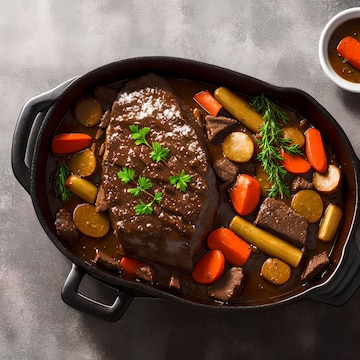The Perfect Pot Roast: A Culinary Classic

Pot roast, a quintessential comfort food, conjures images of cozy family dinners and hearty, satisfying meals. This dish, born out of necessity and perfected over generations, has stood the test of time as a cornerstone of American cuisine. From its humble origins to its status as a beloved favorite, pot roast continues to charm palates and warm hearts.
A Brief History
The roots of pot roast trace back to medieval Europe, where tougher cuts of meat were slow-cooked in large pots over open flames. This method allowed cooks to tenderize the meat while infusing it with rich flavors from herbs, spices, and vegetables. As European settlers migrated to the New World, they brought with them their culinary traditions, including the art of pot roasting.
In early America, pot roast emerged as a practical and economical way to feed large families. Tougher, less expensive cuts of beef, such as chuck or brisket, were braised slowly with root vegetables like carrots, onions, and potatoes, transforming them into meltingly tender, flavorful meals. The dish became a staple on dinner tables across the country, cherished for its simplicity and heartiness.
The Anatomy of Pot Roast
At its core, pot roast is a dish of patience and simplicity, relying on a few key ingredients and slow, gentle cooking to achieve perfection. The classic pot roast typically consists of:
- Beef: Chuck roast is the preferred cut for pot roast due to its marbling and connective tissue, which break down during cooking, resulting in tender, succulent meat. Other cuts like brisket or round can also be used.
- Aromatics: Onions, garlic, and herbs like thyme, rosemary, and bay leaves add depth and complexity to the dish.
- Root Vegetables: Carrots, potatoes, and celery are traditional choices, providing sweetness and substance to the dish.
- Liquid: Beef broth, red wine, or a combination of both serve as the braising liquid, infusing the meat and vegetables with flavor as they cook.
The Art of Cooking Pot Roast
While pot roast is a simple dish, mastering its preparation requires attention to detail and patience. Here’s a basic guide to cooking the perfect pot roast:
- Season the Meat: Generously season the chuck roast with salt and pepper, ensuring even coverage on all sides.
- Sear the Meat: In a heavy-bottomed Dutch oven or large skillet, heat oil over medium-high heat. Sear the seasoned roast on all sides until deeply browned, creating a flavorful crust.
- Saute Aromatics: Add onions, garlic, and herbs to the pot, sautéing until fragrant and softened.
- Deglaze the Pot: Pour in liquid (beef broth, red wine, or a combination) to deglaze the pot, scraping up any browned bits from the bottom for added flavor.
- Braise the Meat: Return the seared roast to the pot, along with any accumulated juices. Add the root vegetables around the meat, ensuring they are nestled in the liquid. Cover the pot and simmer gently over low heat or in a low oven until the meat is fork-tender, usually 2-3 hours depending on the size of the roast.
- Rest and Serve: Once the pot roast is done, remove it from the pot and let it rest for a few minutes before slicing. Serve the tender meat and vegetables with a ladle of the flavorful cooking liquid.
Variations and Tips
While the classic pot roast recipe is timeless, there are endless variations and tweaks to suit different tastes and preferences:
- Flavor Enhancements: Experiment with different herbs, spices, and aromatics to customize the flavor profile of your pot roast. Consider adding ingredients like Worcestershire sauce, balsamic vinegar, or tomato paste for added depth Turfok.net/.
- Vegetarian Options: For a vegetarian twist, swap out the beef for hearty root vegetables like turnips, parsnips, and squash. Braised tofu or seitan can also be used as meat substitutes.
- Slow Cooker or Instant Pot: Pot roast can also be prepared in a slow cooker or Instant Pot for added convenience. Simply follow the same steps for searing the meat and sautéing aromatics before transferring everything to the slow cooker or Instant Pot to cook on low heat for several hours.
- Leftover Reinvention: Leftover pot roast makes excellent sandwiches, tacos, or shepherd’s pie. Shred the meat and incorporate it into soups, stews, or pasta dishes for a delicious second act.
In Conclusion
Pot roast embodies the essence of comfort food, offering warmth, sustenance, and a sense of nostalgia with every bite. Whether enjoyed on a chilly winter evening or as the centerpiece of a festive gathering, this timeless dish continues to hold a special place in the hearts and kitchens of food lovers everywhere. So, gather your ingredients, fire up the stove, and let the aroma of simmering pot roast fill your home with warmth and delight.





